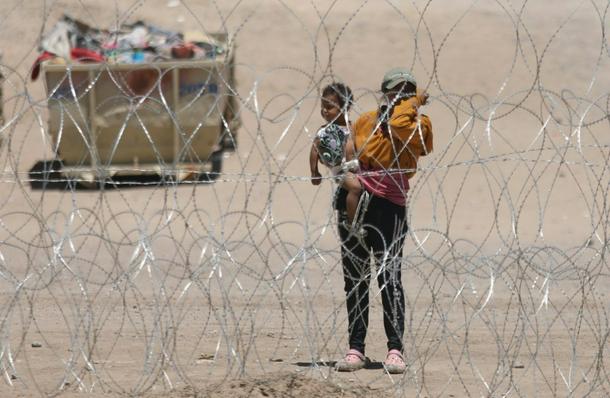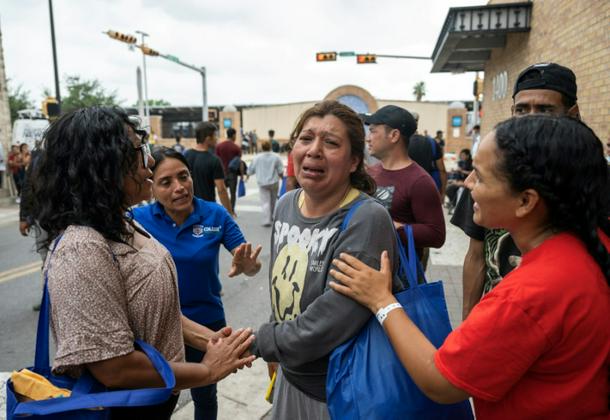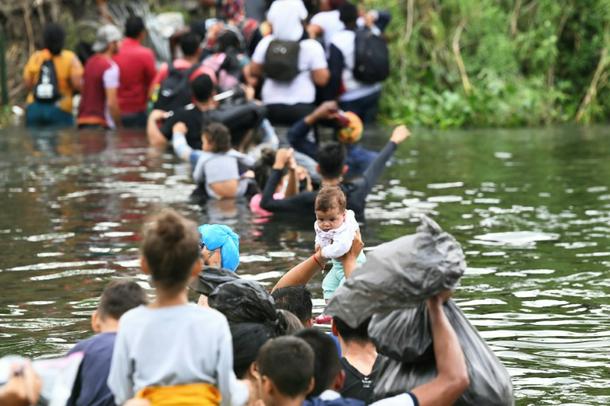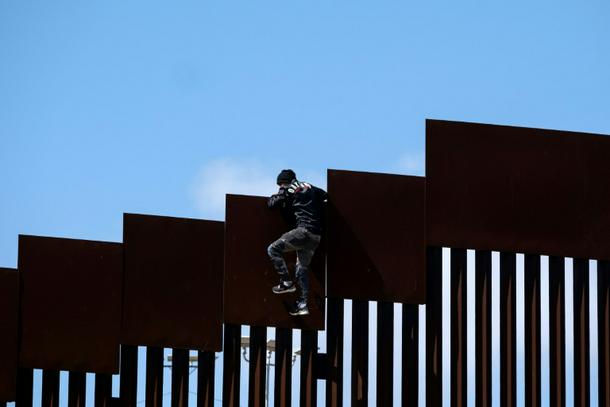
A migrant woman waits to be processed by the Border Patrol in the sector of El Paso, Texas, after crossing from Ciudad Juarez in Mexico on May 11, 2023
El Paso (United States) (AFP) - Pandemic-era controls barring migrants from claiming US asylum expire Thursday night amid fears of chaos at the Mexican border, with a tough new policy spelling uncertainty for thousands seeking refuge in America.
Migrants, mostly from the Americas but some from as far away as Asia, were present on both sides of the frontier as US troops arrived to handle an expected surge of people seeking to cross over.
The White House warned that beginning Friday, anyone entering the United States illicitly will face a lengthy ban and possible criminal charges.
“Our borders are not open,” said Homeland Security Secretary Alejandro Mayorkas.
At the border some made last-minute attempts to ford the narrow but fast-moving Rio Grande River near Brownsville, Texas, hoping they might simply be released into the United States after turning themselves into the Border Patrol.

Patricia Vargas (C) from Venezuela was one of hundreds of migrants waiting for transportation at a bus station in Brownville, Texas -- she was separated from the rest of her family who failed to make the crossing into the United States
“I hope to be able to stay in this country,” said 29-year-old Ecuadoran Jimmy Munoz, just after climbing onto US soil.
“But I have doubts and fears that they will let me.”
Families were split in the confusion: Patricia Vargas from Venezuela wept as she sat at the bus station in Brownsville, where hundreds of migrants awaited the chance for transportation onward.
Her son, daughter-in-law and two grandchildren failed to make the crossing.
“We were five in total and only I was able to get through,” she sobbed.
- Glitchy app -
For more than three years the 2,000-mile (3,200-kilometer) frontier with Mexico has been regulated by Title 42 – a health provision designed to keep Covid infections at bay by turning people away before they made a claim for asylum.

Migrant people try to reach the United States across the Rio Grande, as seen from Matamoros in Tamaulipas state in Mexico on May 11, 2023
But with the formal ending of the Covid emergency, that rule will be lifted when midnight strikes in the US capital (at 0400 GMT) – with new restrictions taking its place.
Those new regulations, crafted by the administration of President Joe Biden as it seeks to alleviate pressure at the border, require asylum-seekers and other migrants to request entry from outside the country.
Five-year bans or criminal charges will be levied against those who try to cross illegally.
The US has pledged to set up processing centers in other countries, and is creating special refugee programs for some places like Haiti as well as expanding temporary work permits.
But how things will play out in practice remains unclear, and the situation has already inflamed America’s heated immigration debate.

A migrant woman and her daughter swim across the Rio Grande river back to Mexico near Matamoros after being prevented from entering the United States
Asylum-seekers are required to seek interviews via a smartphone app – though users report it is glitchy and presents a hurdle for those without working phones or Wi-Fi.
“It’s amazing that an app practically decides our lives and our future,” Jeremy de Pablos, a 21-year-old Venezuelan who has camped out in the Mexican border city of Ciudad Juarez for weeks, told AFP.
Mayorkas defended the app, saying technical issues were being addressed.
“The greatest challenge with respect to the CBP One app is not a technological challenge, but rather, the fact that we have many more migrants than we have the capacity to make appointments for,” he conceded.
- ‘A day of infamy’ -

A migrant climbs over the border fence into the United States after fetching groceries for others waiting to be processed on the US side of the Mexican border
US cities along the border girded for the policy shift, still unsure what it would mean for them after seeing thousands of migrants appear on their streets monthly over the past three years.
Many come from Mexico and three impoverished central American countries, Guatemala, El Salvador and Honduras – though in recent years there has been a jump in people from Colombia, Venezuela, Ecuador, Cuba and Haiti.
The Border Patrol has also seen thousands show up each month from Russia, India, China, Brazil and elsewhere.
In El Paso, downtown was quiet Thursday. AFP correspondents said the press of people who had been gathered around the Sacred Heart Church earlier in the week were gone.
A short distance away, scores of migrants queued in the scorching desert sun behind a tall fence in the no-mans land between the border proper and the rest of America, waiting to be processed by US authorities.
Promised buses did not materialize during the several hours an AFP team watched.
In Brownsville, reporters said there were around 300 people in the bus station waiting for transport, with a regular stream of buses arriving.
Biden continued to be pelted with criticism from the left for making it harder for asylum petitioners to enter the country, and from the right for not maintaining Title 42 to keep migration under control.
Former president Donald Trump – Biden’s leading Republican challenger for the White House in 2024 – suggested Wednesday that the coming change would be a “day of infamy.”
“You’re going to have millions of people pouring into our country,” he claimed in a town hall on CNN.
Mayorkas stressed that the new policy opened more legal pathways for migrants – as long as they go through the CBP One app or processing centers the US plans in Colombia, Guatemala and other countries.
burs-pmh-hg/ec